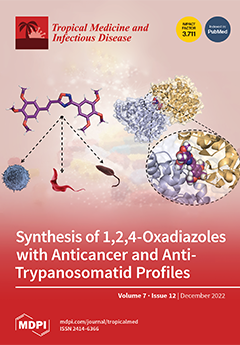The genus
Borrelia encompasses spirochetal species that are part of three well-defined groups. Two of these groups contain pathogens that affect humans: the group causing Lyme disease (LDG) and the relapsing fever group (RFG). Lyme disease is caused by
Borrelia burgdorferi s.l., which is distributed in the Northern Hemisphere, and relapsing fevers are caused by
Borrelia spp., which are found in temperate and tropical countries and are an emerging but neglected pathogens. In some departments of Colombia, there are records of the presence of
Borrelia sp. in humans and bats. However, little is known about the impact and circulation of
Borrelia spp. in the country, especially in wildlife, which can act as a reservoir and/or amplifying host. In this context, the objective of our research was to detect and identify the
Borrelia species present in wild mammals in the departments of Caldas and Risaralda in Colombia. For morphological detection, blood smears and organ imprints were performed, and molecular identification was carried out through a nested PCR directed on the flagellin B (
flaB) gene. A total of 105 mammals belonging to three orders (Chiroptera, Didelphimorphia and Rodentia) were analyzed, of which 15.24% (
n = 16) were positive for
Borrelia. Molecularly, the presence of
Borrelia burgdorferi s.s. in lung tissues of
Thomasomys aureus and blood of
Mus musculus (Rodentia) was detected, with 99.64 and 100% identity, respectively.
Borrelia sp. genospecies from a clade branch of a bat-associated LDG sister group were identified in seven individuals of bat species, such as
Artibeus lituratus,
Carollia brevicauda,
Sturnira erythromos, and
Glossophaga soricina. Furthermore, two
Borrelia genospecies from the RFG in seven individuals of bats (
A. lituratus,
Artibeus jamaicensis,
Platyrrhinus helleri,
Mesophylla macconnelli,
Rhynchonycteris naso) and rodents (
Coendou rufescens,
Microryzomys altissimus) were documented. Additionally, the presence of a spirochete was detected by microscopy in the liver of a
Sturnira erythromos bat specimen. These results contain the first molecular evidence of the presence of
B. burgdorferi s.s. in South America, which merits the need for comprehensive studies involving arthropods and vertebrates (including humans) in other departments of Colombia, as well as neighboring countries, to understand the current status of the circulation of
Borrelia spp. in South America.
Full article






